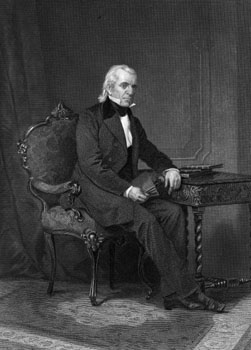Colonial-Antebellum Period (1769-1861)

>Home
>History Introduction
>Next
The first significant exploration and settlement of the Duck River watershed occurred immediately after the French and Indian War. At the war’s end, Britain gained a huge amount of territory, including all of Canada, North America to the Mississippi River (except Florida), Minorca, Majorca, Hong Kong, and India. While determining how to administer his vast new land holdings, King George III issued the famed Proclamation of 1763, which forbade any westward movement by his American colonists beyond the Appalachian Mountains. By 1769, curious frontiersmen, scheming land speculators, and people wanting to start life anew threw caution to the wind and scrambled over the mountains into present-day Tennessee and Kentucky. The initial adventurers, known as Long Hunters, stayed for many years, hunting game to sell in the burgeoning fur trade. Some decided to risk all and set up permanent residence in hostile Cherokee territory. Their existence was hard, and some, like Joseph Brown who was the first settler of Maury County, were captured and held prisoner by the Indians who wanted to stem the tide of interlopers into their homeland.
After the Revolutionary War, North Carolina and Virginia offered their veterans land grants in Tennessee in lieu of payment in specie, opening up the Duck River region to wide-scale settlement. The Antebellum period witnessed the rise of prominent Duck River families, like the Polks and the Pillows, who wielded considerable political power. Duck River soldiers played a prominent role in the War of 1812, which secured America’s independence from the British for a second time.
During the early phase of the Antebellum period, one of the most significant overland trails bisected the region. First in the era of flatboatmen, who used waterways to take their goods to market at New Orleans, were traders who sold their goods and then walked back home via the Natchez Trace. Because of its proximity to the Natchez Trace, the Duck River region was home to a number of booming businesses, including mills, horse breeders, and mercantile establishments.
The Antebellum period also witnessed the rise of slave use in the region, which was embraced by most of the inhabitants whether they owned slaves or not. Most of the counties of the Duck River region, with the exception of the Cumberland Plateau and the closely surrounding area, had citizens who owned a slave or, in Gideon Pillow’s case, hundreds of slaves. A symbol of wealth and prestige, slave owning guaranteed a place of prominence in polite society and the rough-and-tumble world of politics.
James K. Polk rose to prominence as speaker of the U.S. House of Representatives, governor of the state of Tennessee, and finally President of the United States. Generally regarded as one of the ten best presidents in U.S. history, Polk added more land to the continental United States other than Thomas Jefferson. Through the successful prosecution of the Mexican War, Polk added Texas, California, New Mexico, Nevada, and Arizona to America’s land holdings. He also settled the dispute with the British over the boundary between the United States and Canada, and his economic policies, with the creation of an independent treasury, lifted the country out of a depression.
The Mexican War’s conclusion, however, also created more tensions over the issue of slavery, leading to the onerous Compromise of 1850. From 1850 until the outbreak of the Civil War, the debate over slavery continued to mount, and the Duck River region was not exempt from it. When the eventual split came, most citizens supported the Confederacy.